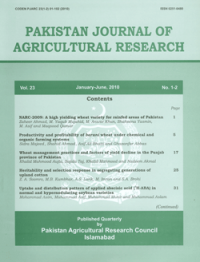ECONOMICS OF WHEAT BASED CROPPING SYSTEMS IN RAINFED AREAS OF PAKISTAN
Parvez Khaliq*, Azim Malik**, Nasir Mahmood Cheema* and Muhammad Umair***
ABSTRACT
The Pothwar tract of rainfed area has enormous potential to meet incremental food grain needs of the country. However, a significant yield gap in wheat has been reported between yields of substantive and the progressive growers mainly due to poor management of soil, water and fertility issues. A field study was conducted at National Agricultural Research Centre (NARC), Islamabad and the traditional wheat-fallow-wheat (W-F-W) cropping system was evaluated with the improved wheat-maize fodder-wheat (W-MF-W) and wheat-mungbean-wheat (W-MB-W) cropping systems. Two tillage practices, i.e. shallow tillage with cultivator and deep tillage with moldboard; and four fertilizer treatments viz., control (C), recommended dose of fertilizer for each crop (F), farmyard manure (FYM) @ -1 5 tha . The recommended doses of fertilizer for individual crop with FYM (F+FYM) were also included in the study to know their impact on the crops yield in the cropping systems. Economic analysis of the data revealed that the traditional wheat-fallow-wheat cropping system could be economically replaced with wheat-maize fodder-wheat cropping system even under drought condition and there will be no economical loss of wheat yield when planted after maize fodder. Application of recommended dose of fertilizer -1 along with FYM @ 5 tha will enhance the yield of wheat and maize fodder. The improved cropping system of wheat-maize fodder-wheat will help the farmers to sustain productivity of these crops, stable economic benefits and improvement in soil nutrients and organic matter over time.
To share on other social networks, click on any share button. What are these?






